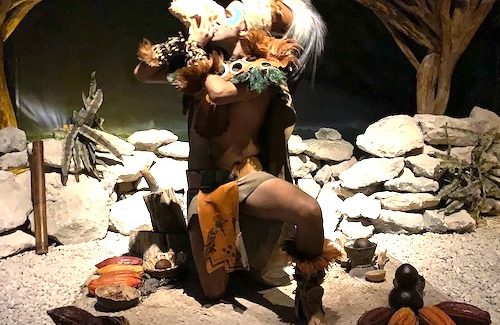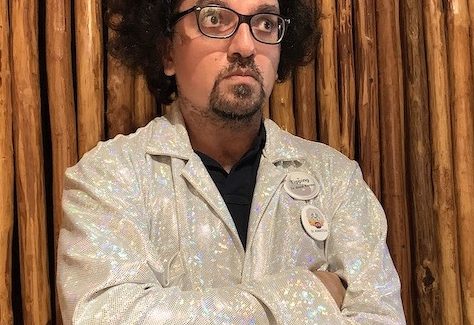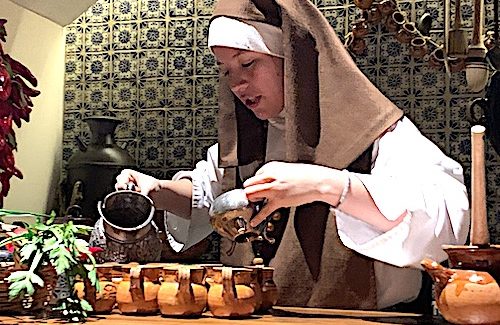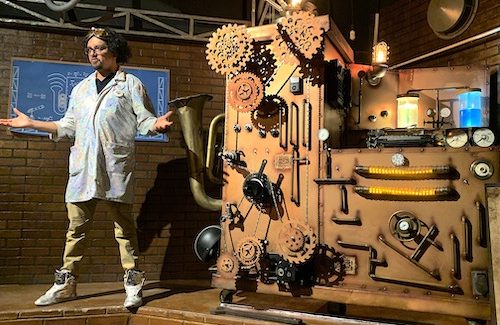Kakaw Chocolate Factory Tour
When a shaman wearing a loin cloth and feathered headdress welcomed us, we knew this was not going to be a typical museum visit.
It wasn’t. Our tour of Kakaw Chocolate Factory in Costa Maya, Mexico, was entertaining, informative and delicious. The three guides were excellent actors who seemed to delight in the characters they were playing – the shaman, Sister Rita the nun and Dr. Adamstein the mad scientist.
I booked the tour on my Celebrity Equinox cruise and am glad I did. The Kakaw Chocolate Factory is a little gem that I didn’t expect to find on the island cruise port.
The whole story involved traveling through time to explore the history of chocolate. It’s unclear when chocolate first came on the scene or who invented it. But pots and vessels used by the ancient Olmecs from around 1500 B.C. were discovered to have traces of compounds found in chocolate and tea.
Since the Olmecs left no written history, it is uncertain how and when the Olmecs used the cacao pods for chocolate. Native to Central and South America, cacao trees bear fruit pods. Each pod contains about 40 cacao beans. The beans are dried and roasted to create cocoa beans, the shaman said.
Then came the ancient Mayans who not only consumed chocolate but revered it. Mayan written history mentions chocolate drinks being used in celebrations and rites. It was an offering to the gods as well as a beverage to celebrate marriages, births and deaths.
“The Mayan chocolate was hot and bitter,” the shaman said. “The Mayans made a drink with toasted and crushed cacao seeds seasoned with corn, vanilla, chili and spices. It was left to ferment and then boiled in water.”
The result was an energy jolt. The Aztecs took chocolate love to an even higher level. They used it for currency to buy goods and cacao beans were considered more valuable than gold.
One of chocolate’s most notorious fans was the mighty Aztec ruler Montezuma II who was said to drink gallons of chocolate each day for energy and as an aphrodisiac.
Before long, chocolate began spreading around the world. A Spanish ship brought it to the American Colonies in Florida in 1641. It was part of soldier rations during the Revolutionary War. I remember my Dad saying it was part of soldier rations when he served in World War II.
Using some kind of magical “transporter,” Dr. Adamstein then took us through time – sharing some dark chocolate snacks to keep up our energy – to a visit with Sister Rita the nun. Continuing the history of chocolate, Rita made small mugs of chocolate for us to drink.
The last stop was some kind of laboratory where the mad scientist asked for a volunteer to help run his huge contraption to save the human race and chocolate from extinction. Each of the settings in the museum was well done and there were plenty of seats to listen to each presentation.
On our final “futuristic” stop, a good-natured guy stepped forward when Dr. Adamstein asked for a volunteer. The man stood patiently while Dr. Adamstein strapped a small helmet on the volunteer’s head and instructed him which dials to turn to try and save us all.
Of course, the volunteer succeeded in saving the world. I have a feeling the volunteers always succeed.
Exiting the museum, we were treated to more chocolate candy samples made on site. It was later in the day or we could have watched chocolate candy being made in the facility. We also could buy various chocolate candy there which many tour participants did.
Story and Photos by Jackie Sheckler Finch


















View Recent Comments